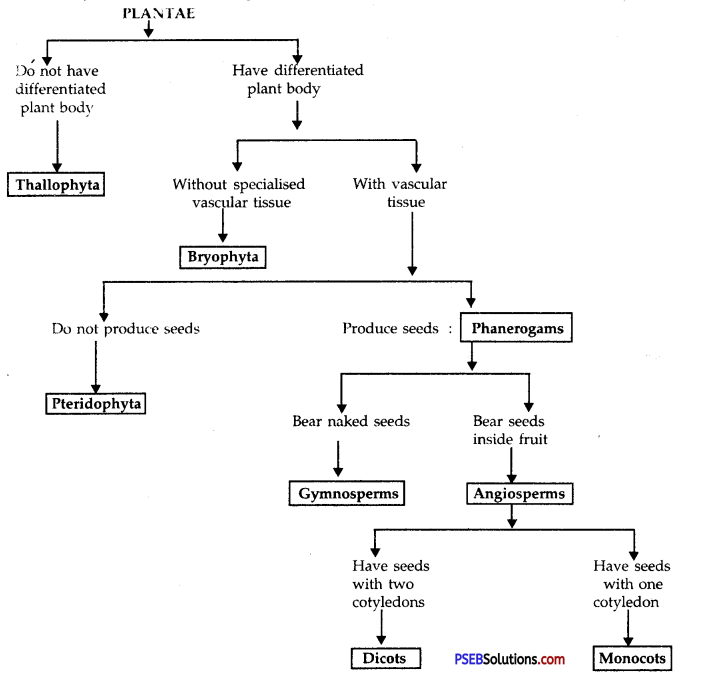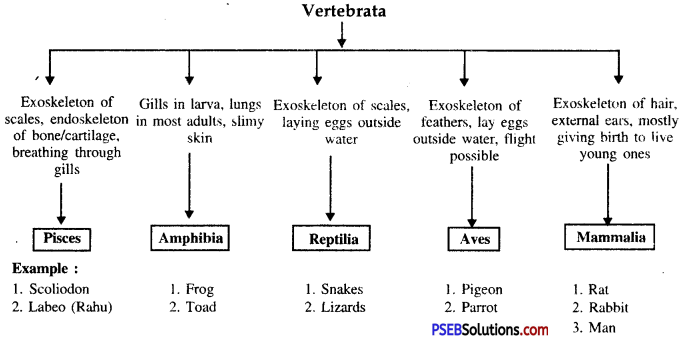Punjab State Board PSEB 9th Class Science Book Solutions Chapter 7 Diversity in Living Organisms Textbook Exercise Questions and Answers.
PSEB Solutions for Class 9 Science Chapter 7 Diversity in Living Organisms
PSEB 9th Class Science Guide Diversity in Living Organisms Textbook Questions and Answers
Question 1.
What are the advantages of classifying organisms?
Answer:
Advantages of classification
- Classification makes the study of wide variety of organisms easy.
- Classification of organisms is responsible for description of species.
- It helps in understanding the interrelation among different groups of organisms.
- Classification of living beings recognises the basic taxonomic units of species.
- It helps in understanding the evolution of organisms.
- Exact identification of insects helps in controlling epidemic diseases like malaria, filaria, dengue fever, kala azar etc.
![]()
Question 2.
How would you choose between two characteristics to be used for developing a hierarchy in classification?
Answer:
Characteristic is a particular form or function. Many inter-related characteristics are used in order to classify all living organisms.
- Nature of cell is basic characteristic of classification.
- Number of cells.
Question 3.
Explain the basis for grouping organisms into five kingdoms.
Answer:
- Nature of cell. Prokaryotic or eukaryotic.
- Number of cells. Unicellular or multicellular.
- Mode of nutrition. Absorptive, autotrophic or holozoic.
Question 4.
What are the major divisions in kingdom Plantae? What are the basis for these divisions?
Answer:
Major divisions of Kingdom Plantae.

![]()
Question 5.
How are the criteria for deciding divisions in plants different from the criteria for deciding the subgroups among animals?
Answer:
Criteria for dividing plants: The eukaryotic multicellular organisms with cell wall and those which carry out photosynthesis are placed under kingdom plantae.
The first level of classification among plants depends on whether the plant body has well-differentiated, distinct components. The next level of classification is based on whether the differentiated plant body has special tissues for the transport of water and other substances within it. Further classification looks at tire ability to bear seeds and whether the seeds are enclosed within fruits.
Criteria for dividing animals into sub-groups: The eukaryotic multicellular heterotrophic and those which lack cell wall are placed in animal kingdom. They are further classified on the basis of extent and type of body design and differentiation presence.
Question 6.
Explain how animals in vertebrata are classified into further sub-groups.
Answer:
Classification of vertebrata

Science Guide for Class 9 PSEB Diversity in Living Organisms InText Questions and Answers
Question 1.
Why do we classify organisms?
Answer:
Classification helps in the study of broad group of organisms with a wide variety in a simple way.
![]()
Question 2.
Give three examples of the range of variations that you see in life forms around you.
Answer:
Different forms in which life occurs on earth
- Size. Microscopic bacteria a few micrometres in size at one end of the size-scale and ~ 30 metre long blue whale and ~ 100 metre tall red wood trees of California.
- Life Span. Pine trees live for thousands of years while insects such as mosquitoes die within few days.
- Colour. Colourless or transparent worms to brightly coloured birds and flowers.
Question 3.
Which do you think is more basic characteristic for classifying organism and why;
(a) the place where they live?
(b) the kind of cells they are made of?
Answer:
The kind of cells is more basic characteristic for classification of organisms. The cells may be prokaryotic or eukaryotic. The presence or absence of nucleus, or membrane bound organelles would reflect on every aspect of cell design and capacity to make a multicellular body.
Question 4.
What is the primary characteristic on which the first division of organism is made?
Answer:
Nature of Cell. Prokaryotic cell or eukaryotic cell.
Question 5.
On what bases plants and animals put into different categories?
Answer:
- Mode of nutrition. Plants prepare their own food by photosynthesis due to the presence of chlorophyll in chloroplasts and animals acquire ready made food.
- Plants are fixed whereas animals are motile.
- Plants show limited growth whereas animals stop growing after attaining a certain size.
- Plant cells are surrounded by cell wall and animal cells lack cell wall.
![]()
Question 6.
Which organisms are called primitive and how are they different from the so called advanced organisms?
Answer:
- Primitive organisms: The organisms which have ancient body designs that have not changed very much. They are also called ‘lower’ organisms.
- Advanced organisms: The group of organisms that have acquired their particular body design relatively recently. They are also called ‘higher’ organisms.
Question 7.
Will advanced organisms be the same as complex organisms? Why?
Answer:
Yes, complexity in design will increase over evolutionary time, hence older (primitive) organisms are simple while younger organisms are more complex.
Question 8.
What is the criterion for classification of organisms as belonging to kingdom monera or protista?
Answer:
The criterion for classification of monera and protista Nature and number of cell. Prokaryotes belong to kingdom monera and single celled eukaryotes belong to kingdom protista.
Question 9.
In which kingdom will you place an organism which is single celled eukaryotic and photosynthetic?
Answer:
Protista.
![]()
Question 10.
In the hierarchy of classification, which grouping will have the smallest number of organisms with a maximum of characteristics in common and which will have the largest number of organisms?
Answer:
- Species will have smallest number of organisms.
- Kingdom will have largest number.
Question 11.
Which division among plants has simplest organisms?
Answer:
Algae (Thallophytes).
Question 12.
How are pteridophytes different from phanerogams?
Answer:
- Phanerogams produce seeds while pteridophytes do not.
- Reproductive organs are hidden in pteridophytes but well developed in phanerogams.
- Pteridophytes have specialised tissue for the conduction of water whereas proper vascular tissues are present in phanerogams.
![]()
Question 13.
How do gymnosperms and angiosperms differ from each other?
Answer:
Differences between gymnosperms and angiosperms:
| Gymnosperms | Angiosperms |
| 1. Seeds are naked. | 1. Seeds are enclosed in fruits. |
| 2. Reproductive organs sporophylls form cones. | 2. Reproductive organs are flowers. |
| 3. Ovules not enclosed in ovary. | 3. Ovules are enclosed in ovary. |
| 4. Xylern lack vessels. | 4. Xylem contain vessels. |
| 5. Companion cells are absent in phloem. | 5. Companion cells are present. |
Question 14.
How do poriferans animals differ from coelenterate animals?
Answer:
Differences between poriferans and coelenterates:
| Poriferans | Coelenterates |
| 1. Numerous minute pores ostia for entry of water and single osculum for exit of water present. | 1. The body bears a single pore. |
| 2. Appendages absent. | 2. Tentacles as appendages present. |
| 3. Intercellular digestion. | 3. Digestion is intracellular as well as intercellular. |
| 4 Spicules or spongin fibres present. | 4. Stinging cells called cnidoblasts present. |
![]()
Question 15.
How do annelid animals differ from arthropods?
Answer:
Differences between annelids and arthropods
| Annelids | Arthropods |
| 1. Jointed appendages absent.
2. Body covered with cuticle. 3. True coelom as body cavity present. 4. Closed type of circulatory system present. |
1. Body bears jointed appendages.
2. Body covered with chitinous cuticle forming exoskeleton. 3. Haemocoel present. 4. Open type of circulatory system present |
Question 16.
What are the differences between amphibia and reptilia?
Answer:
Differences between amphibia and reptilia:
| Amphibia | Reptilia |
| 1. Body wall not covered with any kind of exoskeleton. | 1. Scales or dermal plates present. |
| 2. Body divided into head and trunk. | 2. Body divided into head, neck, trunk and tail. |
| 3. Fertilization is external. | 3. Fertilization is internal. |
![]()
Question 17.
What are the differences between animals belonging to the aves group and those in the mammalia group?
Answer:
Differences between aves and mammals:
| Aves | Mammals |
| 1. Body covered with feathers. | 1. Body covered with hair. |
| 2. Wings present. | 2. Wings absent. |
| 3. Pinna absent. | 3. Pinna present. |
| 4. Diaphragm absent. | 4. Diaphragm present. |
